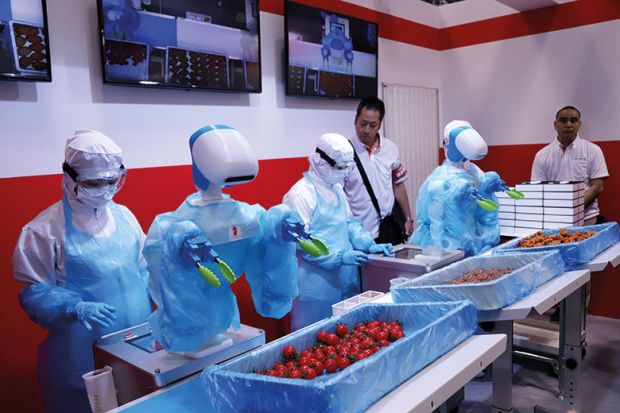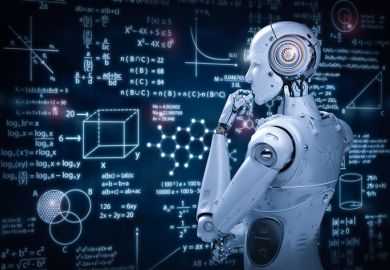There is wide acceptance of the prediction that robots will replace millions of human workers over the next decade. A widely quoted McKinsey study from 2016 predicts that 45 per cent of the activities that people are currently paid to perform could be automated using the technologies currently available.
However, these predictions are based on two questionable assumptions. The first is that the amount of jobs that will be eliminated by robots can be calculated simply by estimating the percentage of existing tasks that robots could perform. This underestimates the “soft” roles that the best employees play in organisations. These include spreading knowhow, suggesting improvements and contributing towards a humane company culture in their dealings with both co-workers and customers. You can see how some of an employee’s responsibilities could be assigned to a robot without their being made redundant by the machine.
Second, it is assumed that corporate executives will replace humans whenever it is proven that machines could do their work more efficiently. But machines have acquisition and ongoing maintenance costs, and need to be reprogrammed before they can take on tasks different from those they were designed for. A business might need to have a high throughput for the investment to be worth it.
Hence, the extent of job losses caused by the fourth industrial revolution may be far less than is currently being predicted. In fact, a position paper published in 2018 by the International Federation of Robotics concluded that future workplaces will mostly have humans and robots working together.
Some glimpses of this future are provided by the cockpits of commercial aircraft. Over time, the task of flying a plane has become highly computer-controlled, yet this has not eliminated the jobs of either flight captains or engineers. Instead, the modern pilot takes turns with the computer to fly the aircraft. However, the training of pilots has changed in significant ways. Pilots now spend more time learning about the automated systems than practising hands-on flying.
Similarly, in the future human-machine workplace, artificial intelligence-based tools will be used to perform specific tasks, within the parameters defined by the programmer. The responsibilities of humans will include taking over control when more complex or non-routine tasks must be performed. Workers will increasingly focus on roles related to unstructured activities, control, coordination and collaboration. According to the IFR, this could include managing production flows, resolving exceptions and bottlenecks, and dealing with customers.
For this reason, employers will place increased emphasis on “soft” skills, such as communication, problem-solving and decision-making under pressure. The new job profiles are also expected to include a strong digital element.
Given the significance of these changes, students must be introduced to the human-machine workplace before they leave college. This demands several changes to current higher education practice. In the US, for instance, a decision must be made about where the credits to teach the new courses will come from. Will general education, business courses or electives be sacrificed?
Moreover, which aspects of the human-machine workplace should be taught? Should colleges adopt a broad goal of exposing students to the benefits, risks and trade-offs of the human-machine workplace? In that case, teaching could focus on the deployment of machine-learning technologies, the ethical and privacy risks they throw up, the psychological and social impacts of artificial intelligence, and how to make the human-machine workplace humane.
Alternatively, colleges may prefer to focus on equipping students with relevant hands-on skills. In that case, the focus would be on things such as problem-solving, creativity, data analysis, introduction to algorithms and visualisation tools.
Lastly, higher education leaders must decide where the content should be taught. What should be taught in information systems departments and what should be housed in functional departments, such as finance, marketing and management?
Robotisation may also necessitate a closer relationship between higher education and professional organisations. One of the goals of such collaborative relationships would be to define the body of knowledge that colleges should teach, as well as what should be left to firms to teach their new hires.
Such collaborations could also create opportunities to better integrate academic and professional training. For example, some college courses could be accredited by professional certification agencies. Similarly, universities may count some exam-based certifications towards the fulfilment of certain courses, enabling students to earn credits towards professional certifications while still in school.
Such collaborations could also pave the way to the integration of human-machine workplace preparation and certification into university programmes that encompass work placements. For example, if a student has completed a certification exam, they could be offered a work placement that would count towards their certification requirements.
Either way, if universities are to fulfil this expanded mission to enhance human productivity in a workplace shared with machines, stronger ties between educators and companies will be essential. If academia and industry fail to collaborate, society might sacrifice the opportunity to effectively prepare students for the emerging reality.
Adenekan (Nick) Dedeke is executive professor of supply chain and information management at Northeastern University.
Register to continue
Why register?
- Registration is free and only takes a moment
- Once registered, you can read 3 articles a month
- Sign up for our newsletter
Subscribe
Or subscribe for unlimited access to:
- Unlimited access to news, views, insights & reviews
- Digital editions
- Digital access to THE’s university and college rankings analysis
Already registered or a current subscriber?




